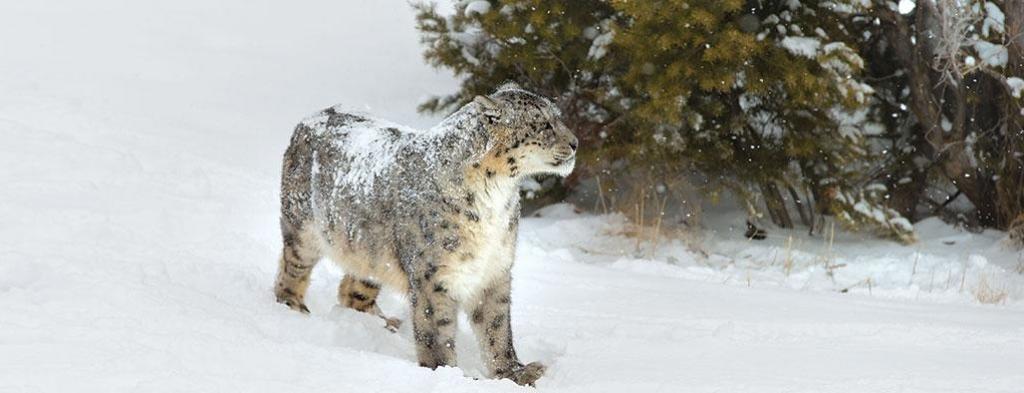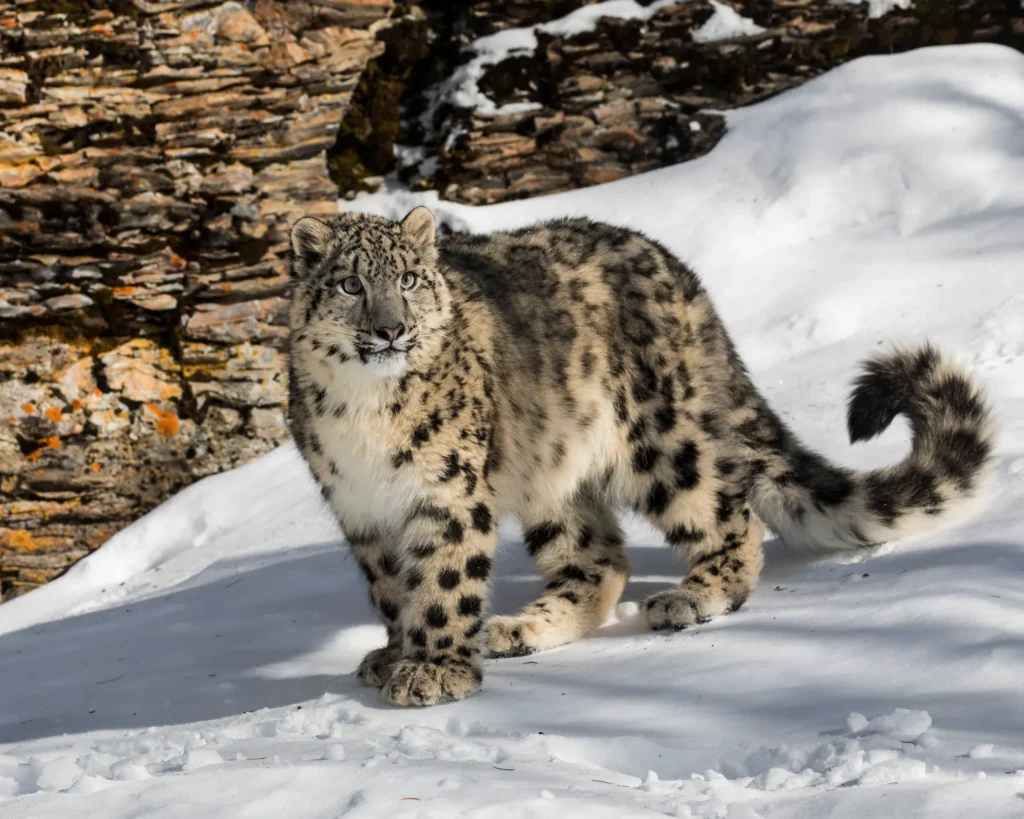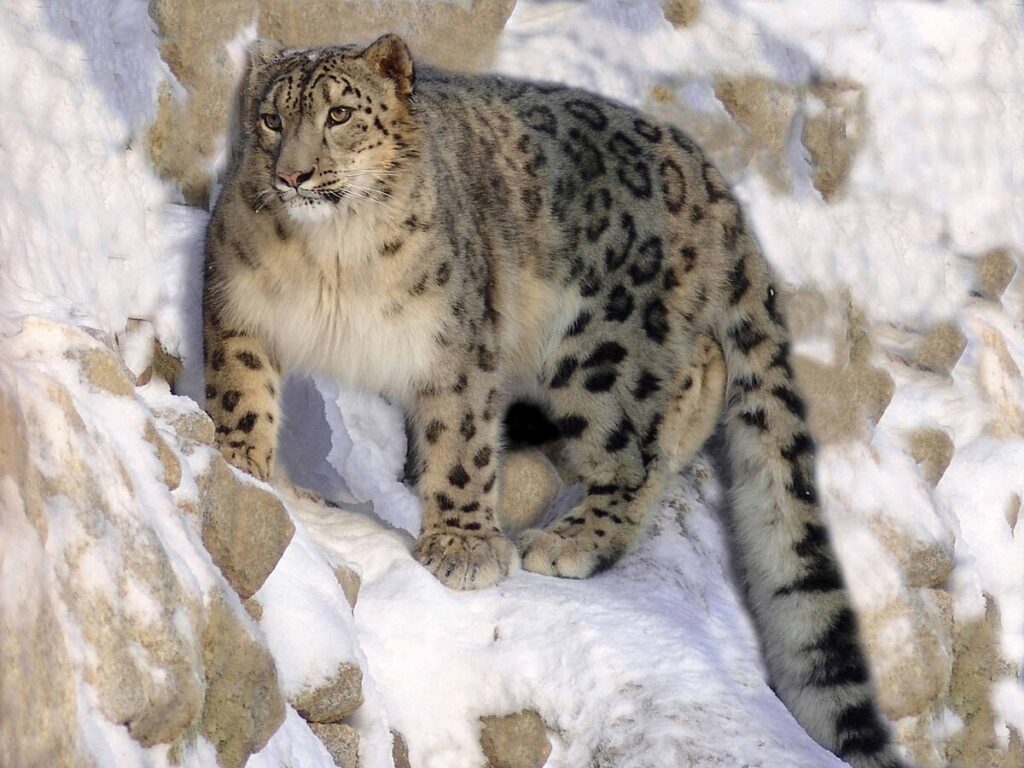Snow Leopards
Introduction:
The snow leopard (Panthera uncia) is a magnificent and elusive big cat native to the rugged mountainous regions of Central and South Asia. Renowned for its stunning smoky-gray or yellowish fur adorned with dark rosettes and spots, the snow leopard thrives in some of the harshest environments on Earth. With an elevated habitat ranging from 9,800 to 17,000 feet (3,000 to 5,500 meters) above sea level, these cats have evolved remarkable adaptations to navigate the challenging terrain of alpine and subalpine zones.
Taxonomy of snow leopard:
The snow leopard (Panthera uncia) belongs to the following taxonomic classification:
- Kingdom: Animalia
- Phylum: Chordata
- Class: Mammalia
- Order: Carnivora
- Family: Felidae
- Genus: Panthera
- Species: uncia

Habitat:
Snow leopards (Panthera uncia) inhabit the high mountain ranges of Central and South Asia. Their habitat includes alpine and subalpine zones characterized by rocky terrain, steep slopes, and sparse vegetation. These elusive cats are adapted to the harsh conditions of their environment, with territories that can span large areas, ranging from 12 to 100 square miles (30 to 260 square kilometers). Their preference for remote, rugged landscapes makes them well-suited to regions where few other large predators can thrive.
Physical Characteristics:
- Coat: The snow leopard’s fur is thick and smoky gray or yellowish with dark rosettes and spots, providing effective camouflage in its rocky habitat.
- Tail: Snow leopards have a long, thick tail, which helps with balance and acts as a warm cover for their face and nose in the cold.

Size and Weight:
Snow leopards are medium-sized big cats. Adult males typically weigh between 77-121 pounds (35-55 kg), while females are smaller, weighing between 55-99 pounds (25-45 kg).
Adaptations to High Altitudes:
Thick Fur: The snow leopard’s fur is dense, smoky gray or yellowish, and covered in dark rosettes and spots. This thick coat provides insulation against the cold temperatures prevalent at high altitudes.
Large Nasal Cavities: Snow leopards have large nasal cavities, enabling them to efficiently extract oxygen from the thin mountain air. This adaptation helps them breathe more effectively in high-altitude environments.
Powerful Hind Limbs: Snow leopards possess strong hind limbs, allowing them to navigate steep and rugged terrain with agility. This adaptation is crucial for hunting and navigating the rocky landscapes of their mountainous habitat.
Long Tail: The snow leopard’s long, thick tail serves multiple purposes. It aids in balance, especially when navigating treacherous terrain, and can act as a cover for the face and nose, providing additional warmth in the cold.
Large Paws: Snow leopards have large, furry paws that act as natural snowshoes, helping distribute their weight and providing better traction on snowy and icy surfaces. This adaptation is essential for their movements in the snow-covered mountains.
Camouflage: The spotted coat of the snow leopard serves as effective camouflage in the rocky and snowy landscapes they inhabit, allowing them to blend in with their surroundings and ambush prey.

Lifespan:
The lifespan of a snow leopard (Panthera uncia) in the wild typically ranges from 10 to 15 years. However, various factors can influence their longevity, and individuals in captivity may live slightly longer. The challenges of surviving in their harsh, high-altitude habitats, along with threats such as poaching and habitat loss, contribute to the average lifespan of snow leopards in the wild.
Diet:
Snow leopards are carnivores, and their diet primarily consists of blue sheep (bharal), Himalayan tahr, marmots, ibex, and other small mammals. They are known for their ability to make incredibly long leaps, aiding them in catching prey.
Behavior:
Snow leopards are solitary animals, and their territories can range from 12 to 100 square miles (30 to 260 square kilometers), depending on the availability of prey. They are most active during dawn and dusk.
Mating behavior:
“Polygynous”
Snow leopards (Panthera uncia) exhibit what is known as “polygynous” mating behavior. Polygyny is a mating system in which a single male mates with multiple females. In the case of snow leopards, during the mating season, a dominant male may establish and defend a territory that encompasses the home ranges of several females.

Gestation period:
The gestation period, or the time a female snow leopard is pregnant, typically lasts for around 90 to 100 days.
Offspring:
Number of Cubs: Snow leopards typically give birth to a litter of two to three cubs, although litters of one to five cubs have been reported.
Maternal Care: The mother takes on the primary responsibility for caring for the cubs. She provides them with milk and protects them in the den during their early weeks of life.
Population:
There are an estimated 4,080-6,590 snow leopards in the wild, but it is difficult for scientists to know for sure. They are listed as ‘Vulnerable’ by the International Union for Conservation of Nature (IUCN) (2023).
Conservation Status:
The conservation status of the snow leopard (Panthera uncia) is classified as “Vulnerable” on the International Union for Conservation of Nature (IUCN) Red List of Threatened Species.

Conservation Efforts:
Various conservation organizations and governments are working to protect snow leopards and their habitats. Efforts include the establishment of protected areas, community-based conservation initiatives, and anti-poaching measures.
Cultural Significance:
Snow leopards are often revered in the cultures of the regions they inhabit. They are considered a symbol of strength and mystery in many local traditions.
Research and Monitoring:
Due to their elusive nature, studying snow leopards in the wild is challenging. Researchers use camera traps, GPS collars, and other non-invasive methods to monitor their populations and behavior.
